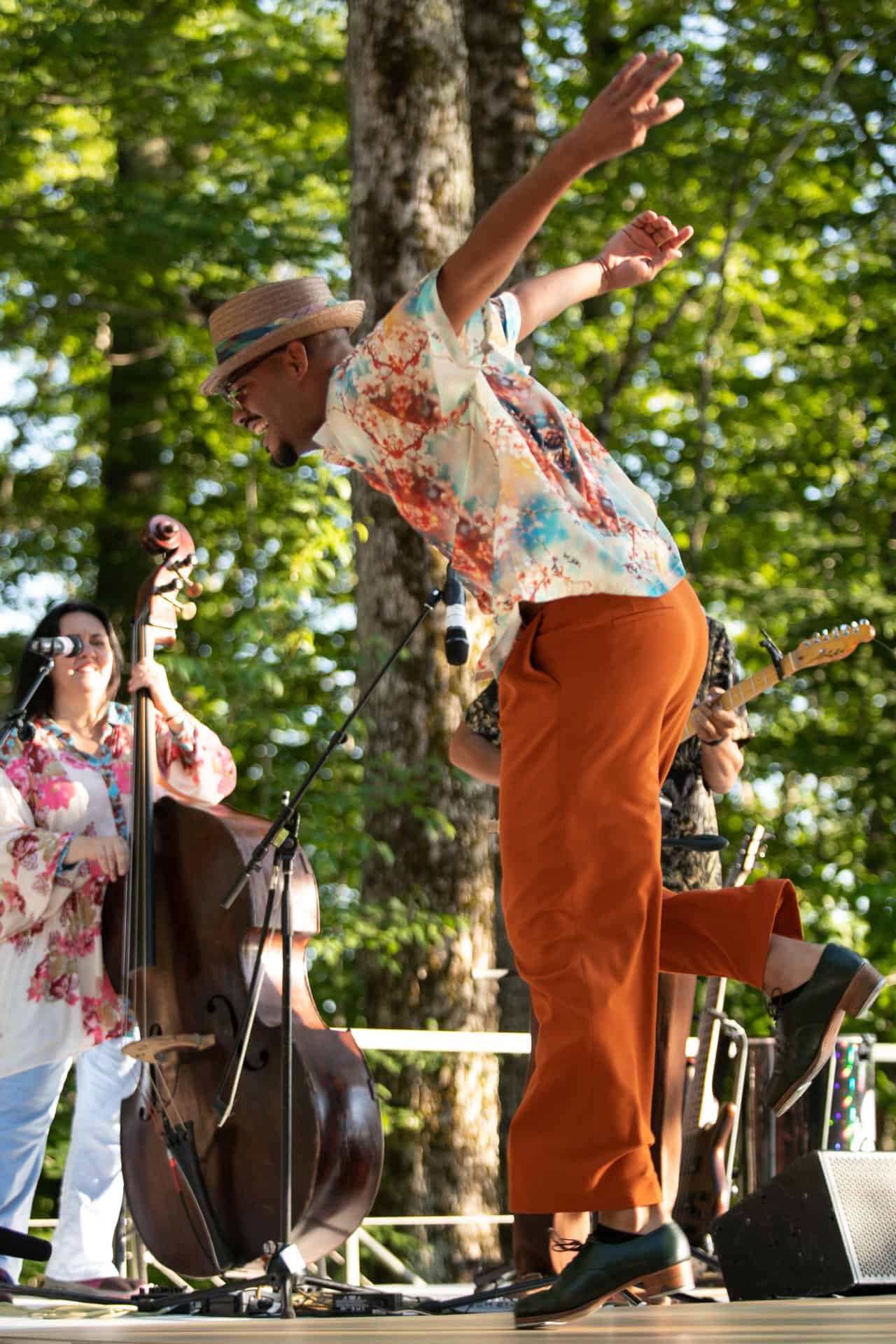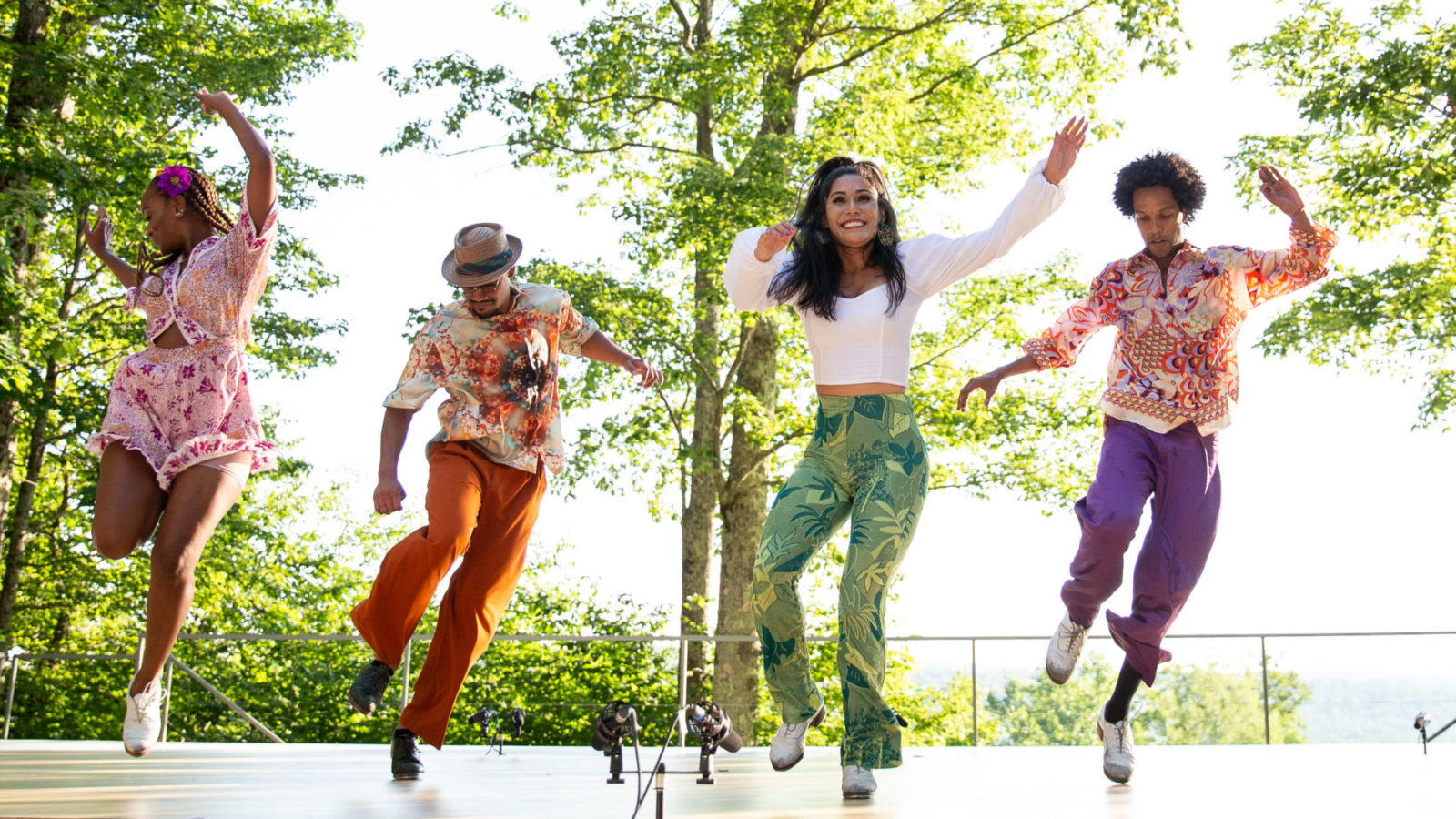Tap shoes flicker in polyrhythms — they are movement and music together, and they’re one with each other and the live music around them. Their body percussion calls to the saxophone and snare drum, the double bass and two-toned beat of an agogo bell.
At Jacob’s Pillow Dance Festival, the internationally acclaimed company Music from the Sole will offer a new form of tap and percussive dance, influenced by the rhythms of Brazil.
They are tapping the energy of Carnival, says co-founder and choreographer Léonardo Sandoval, channeling the intense celebration in the week of Mardi Gras he has always known from home with parades and costumes and music in the streets.

Performers with Music from the Sole perform tap inflected with Brazilian rhythms. Press photo courtesy of Jacob's Pillow Dance Festival.
“Carnival for me and for most Brazilians is like group therapy,” he said by phone from New York. “… It’s cathartic. Yes, there’s the party outside, but there’s a higher level, and it’s almost religious — the energy of the party and the community — it’s so powerful it becomes a connection with the unknown, and the high of that energy …”
He has been trying to bring that current to the stage for nine years, he said, and in the isolation of the pandemic, he and his co-founder, composer Gregory Richardson, have found their way.
He has not been part of a real Carnival party for nine years, he said — not since he came to New York and formed Music from the Sole. The company has become quickly and widely known from Lincoln Center to Tap in Rio.

Performers with Music from the Sole perform tap inflected with Brazilian rhythms. Press photo courtesy of Jacob's Pillow Dance Festival.
Now, from July 20 to 24, they will perform here, for a week on the outdoor stage, with the mountains around them. Eight dancers and five band members will premiere a new work, I Didn’t Come to Stay, partly created here in the Pillow Lab.
Jacob’s Pillow’s artistic director, Pamela Tatge, has followed their work from their beginning.
‘I have a personal connection. My mother was an Italian immigrant who came to Brazil. I spent summers in Sao Paolo, and I fell in love with the music and the rhythms. — Pam Tatge, Pillow artistic director
“I have a personal connection,” she said. “My mother was an Italian immigrant who came to Brazil. I spent summers in Sao Paolo, and I fell in love with the music and the rhythms.”
And in a real sense, she said, Music from the Sole began here. The company has connections with the Pillow from its roots. Sandoval has studied tap since he was six years old, and he had recently come to the U.S. in 2014 when he sent in an application to the Pillow school.
He studied in Becket with Michelle Dorrance, founder and director of the internationally acclaimed company, Dorrance Dance. She was the head of tap at the Pillow School that summer, Tatge said, and Sandoval was such a powerful performer that by the end of the session she had asked him to join her.
Through Dorrance Dance, Sandoval met their music director, Gregory Richardson, a multi-instrumentalist on upright and electric bass, drums, keys and guitar who has performed in music festivals from Australia to Japan to Europe.
They performed together at the Pillow that summer, Sandoval said, and right after that, Richardson asked to perform with him. Sandoval joined Dorrance Dance that fall, and his dance and choreography were taking off, but at the same time he was performing informally in New York, in the streets — invoking the long tradition of street performance in Brazil.
Urban dance styles are born on the street, from West African rhythms to tap and jazz, to passinho and house dance today — Léonardo Sandoval, co-founder of Music from the Sole
Urban dance styles are born on the street, he said, from West African rhythms to tap and jazz, to passinho and house dance today, and he finds it fascinating to trace the communication between them.
Over the next year, he and Richardson began improvising for the pleasure of it. They found a shared love of Brazilian pop music from the 1970s, a movement called Tropicália rooted in soul and jazz. It came to light because of repression and dictatorship, Sandoval said. Musicians in Bahia in Northern Brazil became known for strong and funky music with a political momentum.
Richardson and Sandoval still both actively perform with Dorrance Dance, and as they performed together, they began to gather their own company of musicians in and dancers in New York from diverse backgrounds. And Music from the Sole was born.

Performers with Music from the Sole perform tap inflected with Brazilian rhythms. Press photo courtesy of Jacob's Pillow Dance Festival.
The company celebrates tap’s roots and influences throughout the African diaspora, Sandoval said. They infuse tap with samba, Afro-Cuban rhythms, house dance and contemporary Brazilian forms like passinho — a new dance movement that has grown in the streets, in dance battles and improvisation, from many forms — breakdancing and funk, samba and capoeira.
Bringing together the music of his home country and the long history of tap and percussive dance
“It makes my soul warm,” he said. “I have such respect for the the art forms … they tell a dark story and a hard story.”
And that history feels powerfully relevant to him today.The new work began with missing that kind of community, Sandoval said. It comes from the feeling of hanging out with people you love, in a sense of a community. And it comes from the isolation of the pandemic, knowing for two years that he could not go home to Brazil. He has been working to keep the company together while some of the members have gone home to be with their families.
‘It speaks to my soul,” he said. “I was reading the book while we were creating the piece. … When you’re an immigrant and you come to a new place, you’re resetting and restarting, and you always feel you may not be here long.’ — Léonardo Sandoval
The name, I Didn’t Come to Stay, comes from Maya Angelou, in the opening lines of her autobiography, I Know Why the Caged Bird Sings.
‘What you looking at me for?
I didn’t come to stay …’
‘I hadn’t so much forgot as I couldn’t bring myself to remember. Other things were more important.’
In the pandemic, Sandoval’s husband was reading the book and drew him into it. As the story opens, a Black girl is facing the congregation in a church in Arkansas as they ask her to recall a poem, and she is standing up to everyone who has put her down, shut her out and refused to see her as she is.
“It speaks to my soul,” he said. “I was reading the book while we were creating the piece. … When you’re an immigrant and you come to a new place, you’re resetting and restarting, and you always feel you may not be here long. You don’t know how long you will stay, even if you (end up) staying for a long time.
‘In Portuguese, we have a word for … unencounters, when you’re trying to be together and you can’t. Those dis-encounters drove the work.’ — Léonardo Sandoval
“And then some of the dancers have gone back to Brazil. In Portuguese, we have a word for … unencounters, when you’re trying to be together and you can’t. Those dis-encounters drove the work.”
Covid has brought challenges for live performance, Tatge said, but it has also led to new collaborations. The Pillow and the Guggenheim have come together to create spaces for Music from the Sole. After a series of residencies at the Guggenheim in 2020, the company came to the Pillow Lab as artists in residence in April 2021.
Tatge has been excited to see their newest work unfold, she said. This summer she has seen the premiere in New York, ahead of their week of performances at the Pillow.
“It was glorious,” she said. “… The dance and the music are inseparable. (Leo and Greg) conceive of them together. ‘The dance and the band are all one sonic force,’ that’s what Greg says.”
‘It was glorious … The dance and the music are inseparable. (Leo and Greg) conceive of them together. ‘The dance and the band are all one sonic force,’ that’s what Greg says.’ — Pam Tatge
Tap artists are dancers and musicians at the same time, Sandoval said. He and Richardson create together — the movement shapes the music, and the music shapes the movement. The dancers are playing percussion with their hands and bodies as well as with their feet, and they keep precise time with each other and with the band. But when the group knows the timing in their bones, their movement can grow into closeness and depth.
“We have to become one,” he says in a conversation from the Pillow Lab, “and that one has to be organic.”
It has to be genuine, he adds now, looking ahead. It has to be real.

